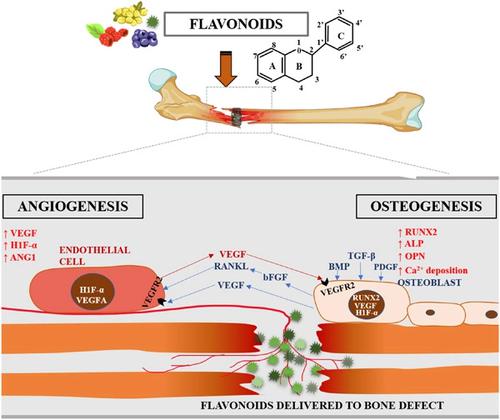当前位置:
X-MOL 学术
›
Biotechnol. Bioeng.
›
论文详情
Our official English website, www.x-mol.net, welcomes your
feedback! (Note: you will need to create a separate account there.)
Angiogenic and osteogenic effects of flavonoids in bone regeneration
Biotechnology and Bioengineering ( IF 3.5 ) Pub Date : 2022-06-19 , DOI: 10.1002/bit.28162 Abinaya Shanmugavadivu 1 , Kalimuthu Balagangadharan 1 , Nagarajan Selvamurugan 1
Biotechnology and Bioengineering ( IF 3.5 ) Pub Date : 2022-06-19 , DOI: 10.1002/bit.28162 Abinaya Shanmugavadivu 1 , Kalimuthu Balagangadharan 1 , Nagarajan Selvamurugan 1
Affiliation

|
Bone is a highly vascularized tissue that relies on a close spatial and temporal interaction between blood vessels and bone cells. As a result, angiogenesis is critical for bone formation and healing. The vascular system supports bone regeneration by delivering oxygen, nutrients, and growth factors, as well as facilitating efficient cell–cell contact. Most clinical applications of engineered bone grafts are hampered by insufficient vascularization after implantation. Over the last decade, a number of flavonoids have been reported to have osteogenic–angiogenic potential in bone regeneration because of their excellent bioactivity, low cost, availability, and minimal in vivo toxicity. During new bone formation, the osteoinductive nature of certain flavonoids is involved in regulating multiple signaling pathways contributing toward the osteogenic–angiogenic coupling. This review briefly outlines the osteogenic–angiogenic potential of those flavonoids and the mechanisms of their action in promoting bone regeneration. However, further studies are needed to investigate their delivery strategies and establish their clinical efficacy.
中文翻译:

黄酮类化合物在骨再生中的血管生成和成骨作用
骨是一种高度血管化的组织,它依赖于血管和骨细胞之间紧密的空间和时间相互作用。因此,血管生成对于骨形成和愈合至关重要。血管系统通过输送氧气、营养物质和生长因子以及促进有效的细胞与细胞接触来支持骨骼再生。大多数工程骨移植物的临床应用受到植入后血管化不足的阻碍。在过去十年中,据报道,许多黄酮类化合物在骨再生中具有成骨-血管生成潜力,因为它们具有优异的生物活性、低成本、可用性和体内毒性最小。在新骨形成过程中,某些黄酮类化合物的骨诱导性质涉及调节有助于成骨-血管生成耦合的多种信号通路。本综述简要概述了这些黄酮类化合物的成骨-血管生成潜力及其促进骨再生的作用机制。然而,需要进一步的研究来研究它们的递送策略并确定它们的临床疗效。
更新日期:2022-06-19
中文翻译:

黄酮类化合物在骨再生中的血管生成和成骨作用
骨是一种高度血管化的组织,它依赖于血管和骨细胞之间紧密的空间和时间相互作用。因此,血管生成对于骨形成和愈合至关重要。血管系统通过输送氧气、营养物质和生长因子以及促进有效的细胞与细胞接触来支持骨骼再生。大多数工程骨移植物的临床应用受到植入后血管化不足的阻碍。在过去十年中,据报道,许多黄酮类化合物在骨再生中具有成骨-血管生成潜力,因为它们具有优异的生物活性、低成本、可用性和体内毒性最小。在新骨形成过程中,某些黄酮类化合物的骨诱导性质涉及调节有助于成骨-血管生成耦合的多种信号通路。本综述简要概述了这些黄酮类化合物的成骨-血管生成潜力及其促进骨再生的作用机制。然而,需要进一步的研究来研究它们的递送策略并确定它们的临床疗效。











































 京公网安备 11010802027423号
京公网安备 11010802027423号